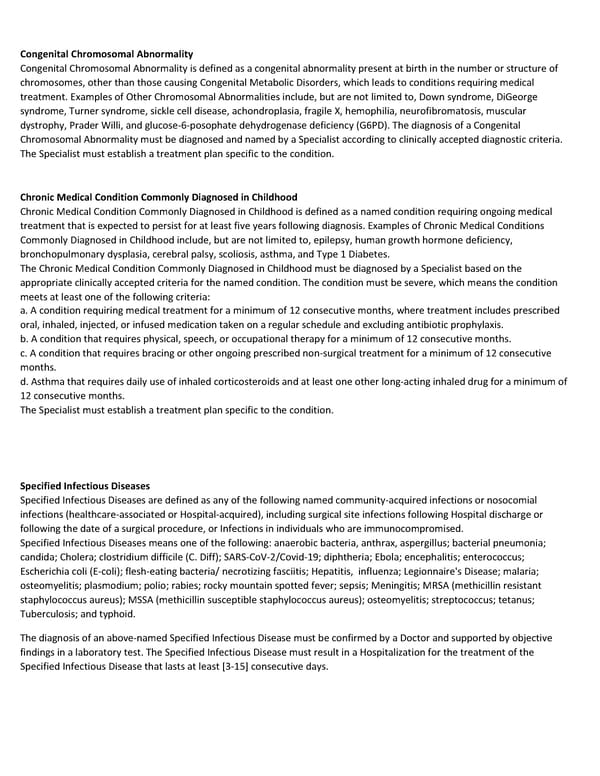Congenital Chromosomal Abnormality Congenital Chromosomal Abnormality is defined as a congenital abnormality present at birth in the number or structure of chromosomes, other than those causing Congenital Metabolic Disorders, which leads to conditions requiring medical treatment. Examples of Other Chromosomal Abnormalities include, but are not limited to, Down syndrome, DiGeorge syndrome, Turner syndrome, sickle cell disease, achondroplasia, fragile X, hemophilia, neurofibromatosis, muscular dystrophy, Prader Willi, and glucose-6-posophate dehydrogenase deficiency (G6PD). The diagnosis of a Congenital Chromosomal Abnormality must be diagnosed and named by a Specialist according to clinically accepted diagnostic criteria. The Specialist must establish a treatment plan specific to the condition. Chronic Medical Condition Commonly Diagnosed in Childhood Chronic Medical Condition Commonly Diagnosed in Childhood is defined as a named condition requiring ongoing medical treatment that is expected to persist for at least five years following diagnosis. Examples of Chronic Medical Conditions Commonly Diagnosed in Childhood include, but are not limited to, epilepsy, human growth hormone deficiency, bronchopulmonary dysplasia, cerebral palsy, scoliosis, asthma, and Type 1 Diabetes. The Chronic Medical Condition Commonly Diagnosed in Childhood must be diagnosed by a Specialist based on the appropriate clinically accepted criteria for the named condition. The condition must be severe, which means the condition meets at least one of the following criteria: a. A condition requiring medical treatment for a minimum of 12 consecutive months, where treatment includes prescribed oral, inhaled, injected, or infused medication taken on a regular schedule and excluding antibiotic prophylaxis. b. A condition that requires physical, speech, or occupational therapy for a minimum of 12 consecutive months. c. A condition that requires bracing or other ongoing prescribed non-surgical treatment for a minimum of 12 consecutive months. d. Asthma that requires daily use of inhaled corticosteroids and at least one other long-acting inhaled drug for a minimum of 12 consecutive months. The Specialist must establish a treatment plan specific to the condition. Specified Infectious Diseases Specified Infectious Diseases are defined as any of the following named community-acquired infections or nosocomial infections (healthcare-associated or Hospital-acquired), including surgical site infections following Hospital discharge or following the date of a surgical procedure, or Infections in individuals who are immunocompromised. Specified Infectious Diseases means one of the following: anaerobic bacteria, anthrax, aspergillus; bacterial pneumonia; candida; Cholera; clostridium difficile (C. Diff); SARS-CoV-2/Covid-19; diphtheria; Ebola; encephalitis; enterococcus; Escherichia coli (E-coli); flesh-eating bacteria/ necrotizing fasciitis; Hepatitis, influenza; Legionnaire's Disease; malaria; osteomyelitis; plasmodium; polio; rabies; rocky mountain spotted fever; sepsis; Meningitis; MRSA (methicillin resistant staphylococcus aureus); MSSA (methicillin susceptible staphylococcus aureus); osteomyelitis; streptococcus; tetanus; Tuberculosis; and typhoid. The diagnosis of an above-named Specified Infectious Disease must be confirmed by a Doctor and supported by objective findings in a laboratory test. The Specified Infectious Disease must result in a Hospitalization for the treatment of the Specified Infectious Disease that lasts at least [3-15] consecutive days.
 Critical Illness Benefits Summary Page 6 Page 8
Critical Illness Benefits Summary Page 6 Page 8